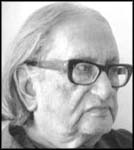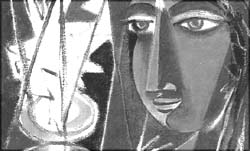 |
 18th April 1999 |
Front Page| |
Sensuous strokes of greatnessRemembering George Keyt- one of Sri Lanka's foremost painters By D.B.KappagodaThe 98th birth anniversary of one of Sri Lanka's foremost modern painters George Keyt fell on April 17.
George Keyt began his schooling in Kalutara at St. Helen's School and later attended Trinity College in Kandy during the principalship of Rev. A.G. Fraser. He did not show much promise in his studies and left school early in 1918. Thereafter he decided to seek a career in Colombo in the well known photography firm Plate where he acquired a skill in improving the quality of photographs. In 1927 he returned to Kandy and decided to become a full-time painter on the advice of his friend Lionel Wendt.
In 1919 Keyt did black and white reproductions of Gauguin. Martin Russel, who wrote a monograph on Keyt said, "Composition of these and the drawing of the figures both often so formal, so squat, so motionless, so unlike anything in Hindu art did not appeal to him." The artist Hugh Modder brought colour reproductions of modern European art with him when he returned to Sri Lanka. Keyt saw them and was impressed. The works of Renoir, Cezanne and Picasso helped Keyt to appreciate and understand the artistic feelings conveyed through them. The early works of Keyt painted between 1927 and 1929 show the influence of Winzer in the treatment of figures. The gracefulness of Sigiriya figures, the use of calligraphic line and the acceptance of European realism were seen in these works. In Hindu sculpture and art, the male form is shown as soft and feminised while the female form is greatly accentuated. Keyt was more interested in the female form and he seldom painted the male nude. He was one of the first artists to paint the female nude. He painted Govindamma in 1928 showing his own style free from Winzer's influence. It showed the synthesis of certain European and Hindu concepts. This aspect made Russell comment, "The nationalism is European, the pose, the placing of the two figures, the long almost calligraphic outlines and the sculptural quality remind one much of Sinhalese and Indian art." In the painting, "Sri Krishna with the Gopis," done in 1928, the Gopis enjoy a luxury and dignity of form. The figure of Krishna while not free from Winzerian feeling is also much closer to a Hindu view. From 1929, Keyt began to paint his landscapes with an emphasis on structure. It was a different approach. His landscapes were not abstract. It has been said, "The landscapes were primitive to the point of being purely diagramatic. If a river had to be shown it was shown as an aerial photograph. Objects like mountains, slopes, expanses of water, paths, trees and buildings were shown as recognisable objects." After about 15 years he did not paint landscapes. Before 1920 Keyt exhibited his pen and ink drawing of a head at an exhibition organised by the Ceylon Society of Arts in Colombo. However his first serious exhibition was in 1928- a memorial exhibition to honour the work of W.W. Beling along with his son J.C Beling whose works were also included. In 1929 Keyt, exhibited his works at the Art Club along with Winzer, Deraniyagala, Beling, George De Niese, J.D.A. Perera and others. In fact it was George de Niese who taught Keyt the finer points in painting. At the joint exhibition with Beling, at the Fergusan Memorial Hall in January 1930, Keyt exhibited his Kandyan Scene, Victoria Drive, Udawattakele, Sajiya Tala, Rehearsal at the Tamil Theatre, Kovalan, and Still Life with Cannas. There were mixed feelings among those who viewed this exhibition. Pablo Neruda, the Chilean poet said of his works: "In all his work there is the moderation of maturity, the beautiful stability of achievement- qualities most precious in so young an artist. Magically though he places his colours, Keyt's pictures produce a dramatic effect, particularly in his paintings of Sinhalese people. "These figures take on a strange expressive grandeur and radiate an aura of intensely profound feeling." In May the same year, at the exhibition of the Art Club, Keyt exhibited for the first time the portrait of Govindamma. The exhibition held in January 1932 was a farewell to Winzer. After the annual exhibition in May that year one saw the total break up of the Art Club. In the same year Keyt and Beling jointly held their exhibition at the motor showrooms in Colombo. It was the end of a period in Keyt's art. Upto this time he did mostly calligraphic drawings. But the general effect remained representational. The year 1933 marked a new trend in his nudes and still life paintings. The Still Life with Buddhist Objects and Still Life with Mangoes show these changes. He also began to depend on Hindu mythology. The stories woven round Krishna and Siva became his subjects. The formation of the '43 group through the initiative of Lionel Wendt was a landmark in the history of art in Sri Lanka. The group organized a one - man exhibition for Keyt in 1949 before he left for India. The paintings that were exhibited were painted between 1942 and 1946. Among the paintings, the series of small heads of women popularly known as "Nayika" was considered "Keyt's most valuable and important contribution to art." |
||
 |
More Plus * Book review
Front Page| News/Comment| Editorial/Opinion| Business| Sports | Mirror Magazine |
|
 |
Please send your comments and suggestions on this web site to |
|
 Keyt
was born on April 17, 1901 at Ampitiya in Kandy. His parents, Henry Keyt
and Constance Sproul were Burghers.
Keyt
was born on April 17, 1901 at Ampitiya in Kandy. His parents, Henry Keyt
and Constance Sproul were Burghers.  Before
long Wendt organised an exhibition at the Art Centre Colombo with some
of his collections of Keyt's paintings. The leading artist of the day C.F.
Winzer was the chief inspector of Art in schools and was keen on improving
art by teaching it in schools.
Before
long Wendt organised an exhibition at the Art Centre Colombo with some
of his collections of Keyt's paintings. The leading artist of the day C.F.
Winzer was the chief inspector of Art in schools and was keen on improving
art by teaching it in schools.